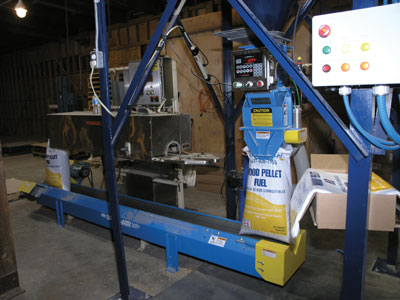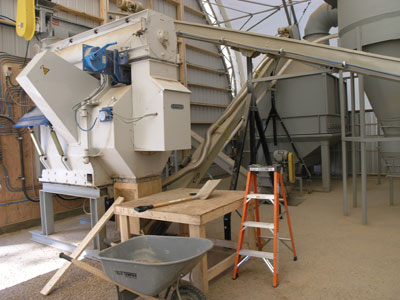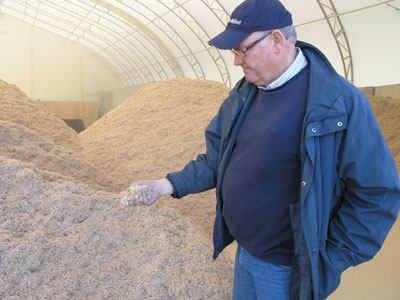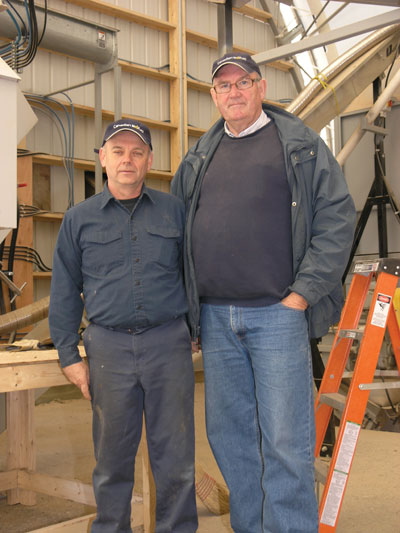
Canadian Biofuels opens Ontario pellet plant
June 1, 2012
By
Scott Jamieson
IT’S an odd place to build a wood pellet plant, but then the original goal wasn’t to make pellets from wood
IT’S an odd place to build a wood pellet plant, but then the original goal wasn’t to make pellets from wood. The pellet plant in Springford, Ontario, owned by Canadian Biofuels Inc. started production in March 2012 as an energy supplier surrounded by orchards and farmland, hundreds of kilometres from any serious wood products industry.
 |
|
| Like much of the plant, the bagging line has an agricultural heritage and is designed to keep pace with production from two pelletizers.
|
The one-mill plant is currently running on wood waste from communities across southwestern Ontario, which has turned out to be an excellent raw material, explains president and CEO Ian Moncrieff. Still, it’s not quite the feedstock the entrepreneur had in mind when he cooked up the idea over five years ago.
“I’m an environmental planner by trade, and was working part time as a professor with the University of Guelph at the time,” Moncrieff explains. In fact, that academic background is not hard to believe as he settles in to recount the history of Canadian Biofuels and agro-biomass 101.
“I was approached by several greenhouse operators from Leamington, a vegetable growing area south of here. They had switched to biomass in the face of $8 and $10 natural gas,” he says. “They were using ground wood waste, and at the time the Ministry of the Environment was looking at some onerous regulations that would have discriminated against biomass. Here were a bunch of growers trying to divert 250,000 tons of wood waste from landfill to displace fossil fuels, and the government was trying to do whatever it could to discourage it.”
Moncrieff was part of a successful lobbying effort to avoid the new regulations. In the process, he was introduced to a group of small to medium-sized greenhouse operators who wanted access to pellet boiler technology, but had no local industrial pellet supply.
The first step was to look at the massive supply in British Columbia, but the west-to-east rail costs made the option more expensive than the inflated natural gas prices. Moncrieff was looking for other options when his wife Roberta, who has been involved in the operation since the beginning, came across examples from Austria of pelletizing purpose-grown energy crops.
“The criterion was that they were to be grown not on good crop land, but marginal land. At the time the local tobacco industry was vanishing, and local development agencies were looking for something to replace part of it using the region’s sandy soils. This seemed to fit the two needs.”
Moncrieff started looking into government programs aimed at diversifying the region away from tobacco, and approached several communities to gauge interest. It all seemed to click, as he found a very receptive audience in the Township of Norwich, about 40 minutes south of London, located a site and got financing lined up. And then the bottom fell out like it did for so many alternative energy projects.
“The fall of 2008 hit, and all credit basically evaporated, putting everything on hold,” Moncrieff recalls.
Back at it
When the dust cleared in the spring of 2009, it was back to the drawing board. By December, Canadian Biofuels had acquired a new site, an old Cargill grain elevator operation in Springford, and had sold an associated grain dryer to generate enough cash to start designing the mill. In the spring of 2011, the company sealed a financing mix that included an investor, the Royal Bank, and the Sand Plains Development Fund (a tobacco diversification program), and started putting the plant together.
 |
|
| The Muench pelletizer started up quickly and was chosen for its expected long die life.
|
By the summer of that year, Canadian Biofuels was running a pilot pellet mill, complete with feed hoppers, conveyors, a vertical mill and cooler. The main goal was to test feedstocks prior to committing to any one option.
“We’ve got a number of feedstock options, from recycled wood to agricultural by-products and purpose-grown crops,” says Moncrieff. “The small mill is noisy, but it makes high quality pellets, and on a good day it’ll make 300 to 400 lb/hr, which allows us to mix and match feedstocks, run them through the lab and test them in our own stoves.”
One early option was a local supplier, but test runs, lab work and test burns proved that it was too contaminated. “Ash was above six per cent, and our stoves were basically choked after an hour.”
Soon after, however, they found a supplier willing to put the work at creating a clean supply – a local waste management company, Norfolk Disposal, set up a sorting system and grinder at a nearby greenhouse. The mixed or contaminated recycled wood stream goes to the greenhouse’s more forgiving boilers, while the clean manufacturing off cuts and stock is ground to the 1/4-in size range and delivered to Canadian Biofuels.
“They want to work with us, they’re sorting, it’s all on an asphalt pad, so there is no contamination, no rocks, no grit. From that supply we’re in the less than one to 1.5 per cent ash range.”
The resulting pellets also test in the 8,500 to 8,800 btu/lb range. When running full tilt, the mill will require three to four walking floor trailers a day of ground material, and Moncrieff says the supplier has more than enough in the pipeline.
“We started off thinking we’d be using agricultural feedstock, and we eventually will, but right now we have a quality supply that is costing well within our economic model, and on top of that we’re diverting significant volumes away from landfill. It’s not a bad model.”
Simple mill
The production process itself is about as simple as a pellet mill gets. Fibre is delivered by the contractor in walking floor trailers and unloaded under the cover of a brand new MegaDome structure. The arched building was affordable, supplies excellent natural lighting and is easily expanded, says production manager Russ Carroll.
 |
|
| “It’s excellent fibre for pellets, and it would otherwise end up in landfill,” says Ian Moncrieff.
|
“Material arrives at between eight and 11 percent moisture, although the mill has handled up to 15 percent without issue,” he explains. “To date, we have not needed a dryer, but we have priced one should we change feedstocks and require one.”
The company is looking at adding a hammer mill to create a more consistent raw material, and it would be located outside for safety, even though the fibre makes quality pellets.
Currently, fibre is carried right into the mill via two stationary walking floor trailers, a unique system that was driven by the need to control cost and complexity. “We looked into various infeed options, which were pricy, and in the end they all served the same basic function as a walking floor. We got that one at $6,000 and the other at $15,000,” he says while pointing at the two reconditioned trailers. “We added power packs and tied them into the PLC, and we were off to the races.”
From here, fibre goes across an Eriez magnet to pull out tramp metal, and then to the solitary Muench pellet mill. The Muench unit was chosen after discussing options with local pellet mill supply and service experts at ANBO and Dorssers.
“We’ve been very lucky to have these two pellet industry suppliers close by in Blenheim, to sound off design and equipment ideas, and ANBO helped out with design and start up. We were looking for something that would give us a long life, was easy to maintain, reliable, and reasonably priced. This was one of the designs they suggested.”
Pellets are conveyed to a reconditioned counter-flow cooler acquired from ANBO, and then off to a 72-ton storage facility via a Farm King screening system. The mill’s bagging line is designed to keep up with two pellet mills, as the facility was designed to easily add a second mill right next to the first as sales grow.
To market
Annual production capacity is currently 25,000 tons, and Canadian Biofuel was already building inventory in both bags and totes when we were on site in late March. While the initial goal was to supply local greenhouses, the recent collapse in natural gas prices means that most of these would-be clients are burning very little biomass these days.

|
|
| Production manager Russ Carroll (left) and Ian Moncrieff at the pelletizer. “The recycled wood is making a very nice pellet, with excellent heat value.”
|
“We’ve looked elsewhere as a result,” Moncrieff says. “We’re marketing to consumers who are off the natural gas grid, so competing with oil, propane or electricity. In those cases we can shave 50 percent off their heating bills. There are also some greenhouses still using biomass. We’ve also been in discussions with locally-run hardware chains who are intrigued by a local supply.”
Of course the 25-degree weather southern Ontario was enjoying in March was not helping matters, but Moncrieff remains confident. Nor has he forgotten his dreams of growing tomorrow’s energy in the sandy soils off Lake Erie.
The company is involved with several local players and trials evaluating purpose-grown crops like miscanthus, and in fact has done some pelletizing and burning trials using a local supply. It is also the aggregator and pelletizer for a $2.6 million research trial involving the Ontario Federation of Agriculture (OFA), Ontario farm research organization OMAFRA, Ontario Power Generation and 900 test acres of fuel crops. Canadian Biofuels is also discussing participating in torrefaction trials with researchers at the University of Western Ontario in London.
“We still see that as the end game. With 12,000 to 15,000 acres of miscanthus, we could make 100,000 tons of pellets here no problem, and that would all come from within a 20-kilometre radius on marginal soil. We have some projects on the side to get us there, but right now the focus is on the core business. We need to get the mill running full out as is, and sell our product.”
Print this page